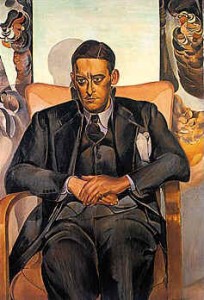T. S. Eliot: Ultra-Conservative Dandy

Source#
From The Jonathan Bowden Archive
T. S. Eliot: Ultra-Conservative Dandy#
For a brief period in the late 1990s there was an attempt to demonize T. S. Eliot as an anti-Semite. This opinion was most ably canvassed by Anthony Julius’ T. S. Eliot, Anti-Semitism and Literary Form, but the attempt failed, and Eliot’s reputation as a poet now stands even higher than ever.
Thomas Stearns Eliot’s most controversial book was the collection of essays drawn from a series of lectures he gave in 1934 called After Strange Gods: A Primer of Modern Heresy. In this book, Eliot argued for an organic society — primarily from a Christian perspective — and he took a decidedly non-philo-Semitic position, considering that the more organic the society, was the better its prospects.
It seems an utter travesty, at this date, that the most famous English language poet of the twentieth century should be treated in this way.
For the interesting things to say about this fey, classical, and austere man have little to do with this (or his marriage to Vivienne Haigh-Wood in 1915) but, rather, revolve around his contribution to literary criticism. In this regard, his development of the idea of a tradition within a writer’s oeuvre proves crucial — witness his own distancing over time from the thesis of “The Wasteland” and “The Hollow Men” as he turned to Christianity, metaphysically speaking. The idea of not seeing works in isolation but from a whole perspective is very interesting in a deeply conservative way.
This further ramifies with Eliot’s coolness and classicism in the arts — if compared and contrasted to his hostility to the Romantics, particularly a left-wing revolutionary like Shelley. (Eliot would have had no time for the literary prognosis of the Trotskyist Paul Foot in his Red Shelley.) Nonetheless, for him, poetry was a codification but never a standardization. It was an escape from emotion through distancing — rather than an achievement of emotional excess through revelation. All of this led to his espousal of the metaphysical poets — Donne, Vaughan, Marvell, and Thomas — as he praised their use of metaphysics in poetry to provide a unified sensibility.
Possibly Eliot’s most famous literary idea was the objective correlative — whereby he sought a general, and culturally relevant, explanation of works which transcended personal responses to them. This involved a semi-objective as well as a subjective reading of the text. A piece attempts to mean what it says, but it also indicates states of mind and experiences which are factual and that can be essayed without being unduly personal about literature.
This hunt for a more general meaning indicates a social vision for art in a man whose own work is very abstruse and ‘difficult’ to understand. This is particularly true of the early poems such as “The Love Song of J. Alfred Prufrock” (1917) and “The Wasteland” (1922), but changes somewhat after “Ash Wednesday” in 1927.
If we might turn to the poetry now: “Prufrock” begins with a stream of consciousness which is typical of early modernism — although much of Eliot’s early poetic vision owes something to his discovery of Arthur Symonds’ The Symbolist Movement in Literature in 1908. Prufrock begins with comparing the evening to an etherized patient upon a table which was considered scandalous at the time when Georgian poetry was all the rage. There is even a hint of the right-wing nihilism of Gottfried Benn in early Eliot. In “Prufrock” he deals with a disappointed life, states of physical and intellectual inertia, and the absence of both carnal love and spiritual progress.
In October 1922 “The Wasteland,” edited extensively by Ezra Pound, made its appearance and extended the analysis, amid many other concerns, to his failing marriage to Vivienne, both of whom were suffering from nervous and mental disorders at the time. The poem definitely chimes with the post-First World War disillusionment of an entire generation.
“The Hollow Men” in 1925 confirms and extends this triad of despair until his conversion to Anglicanism from Unitarianism in 1927. This event was definitely the key metaphysical moment in this very fastidious man’s life. The hunger for meaning and a dormant metaphysical purpose came out. For, in his conversion or re-conversion, Eliot illuminated the idea that life is spiritually barren and meaningless without an over-arching quest, sensibility or teleology.
Certainly once his conversion is definite, the pitch of Eliot’s life and his poetry (above all) takes a decisive turn. “Ash Wednesday,” the “Ariel” poems, and the “Four Quartets” (for which he was awarded the Nobel Prize in 1948) are much more certain in their direction, as well as being more casual, melodic, and contemplative in their creative method. Although secular literati remain discomfited by these poems’ transparent religiosity. This is nowhere more apparent than in the “Four Quartets” which is immersed in Christian thought, traditions, and imagery.
Much of his creative energy after “Ash Wednesday” went into writing plays in an attempt to broaden the poet’s social role — all of these pieces were verse dramas. The whole point of Sweeney Agonistes (1932), The Rock (1934), and Murder in the Cathedral dealing with Thomas a Beckett’s assassination was to bring a larger or wider audience to a conservative purpose for Christian poetry.
For Eliot is that rare thing in twentieth century literary art — an ex-nihilist, someone who reverses the positions of Dostoyevsky’s The Possessed (without the enervation) and wanders back towards C. S. Lewis, Belloc, and Chesterton. I think the key point about these partial dandies and Right-wing conservative intellectuals is their belief in belief. . . . For, without the prospect (even in its absence) of metaphysics, life had no ultimate meaning for them, or for us. Almost everything else about them is incidental to this truth.
